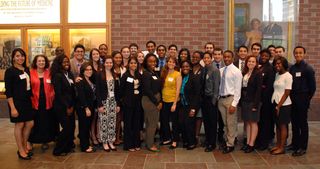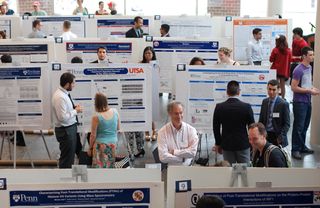 Every summer, the news is filled with profiles of summer student programs, and those that are aimed at increased participation by minority students in STEM are no exception.
Every summer, the news is filled with profiles of summer student programs, and those that are aimed at increased participation by minority students in STEM are no exception.
The Summer Undergraduate Internship Program (SUIP) at Penn Medicine is one such program. Assistant Dean for Research Training Programs Arnaldo Diaz, PhD, showed me around the SUIP Research Symposium last week and introduced me to some of the 33 amazing students who were wrapping up their 10-week internships.
The 2014 SUIP cohort included students from 25 institutions throughout the United States and Puerto Rico, as well as five students conducting research on the social sciences and humanities. In existence since 1993, SUIP has been steadily achieving its mission for the last two decades - most of the program’s students go on to complete PhD, MD-PhD, or other professional degrees. This year, 18 percent of incoming underrepresented minority graduate students in the Perelman School of Medicine are previous SUIP participants. Diaz attributes SUIP’s long-term success to Penn faculty’s strong support, excellent mentoring, and commitment to biomedical education.
Diaz, who has run SUIP since the summer of 2010, says this program is one of the most rewarding parts of his job, but also one of the most challenging: “It’s hard to choose just 30 or so students each year out of about 800 applications.” Before transitioning to an administrative position, Diaz completed an NIH postdoctoral fellowship in Ian Blair’s lab in the Department of Pharmacology at Penn.
 The five students with whom I had a chance to chat each exemplify SUIP’s broad goals for their interns. For example, bioengineering major Bria Macklin, 20, a rising senior from North Carolina A&T State University, worked in the lab of Jason Burdick, Department of Bioengineering. Macklin studied BMP2, a protein that encourages bone formation, but is hard to control. She questioned if adding another protein, SDF1, could help better guide BPM2’s therapeutic capabilities. “I spent two summers at other programs and coming to Penn let me learn new techniques and work with new types of tissues,” she says of her time in the Burdick lab.
The five students with whom I had a chance to chat each exemplify SUIP’s broad goals for their interns. For example, bioengineering major Bria Macklin, 20, a rising senior from North Carolina A&T State University, worked in the lab of Jason Burdick, Department of Bioengineering. Macklin studied BMP2, a protein that encourages bone formation, but is hard to control. She questioned if adding another protein, SDF1, could help better guide BPM2’s therapeutic capabilities. “I spent two summers at other programs and coming to Penn let me learn new techniques and work with new types of tissues,” she says of her time in the Burdick lab.
Macklin’s experience typifies how the lab-intern matching works for all SUIP students. Based on applicants’ interests, they are paired with an advisor who is a member of the Biomedical Graduate Studies (BGS) faculty at Penn. The intern participates in ongoing research within the investigator's lab and is mentored by a postdoc or PhD student.
Educating the whole student inside and outside the lab is also a big part of SUIP. Each week, interns attend research seminars presented by BGS faculty to expose them to a breadth of disciplines, as well as social activities such as Phillies games, concerts, plays, and trips to the shore. Osvaldo Rivera, 18, a molecular biology major and rising junior from the Universidad Metropolitana, Puerto Rico, learned of SUIP when Diaz gave a symposium on Penn summer programs in San Juan last year. Rivera worked in Eric Brown’s lab, Department of Cancer Biology, on identifying sites of genomic instability, which can correlate to cancer mutations. “There’s so much to learn and do in so little time,” says Rivera. “I really can’t do this type of research back home.”
A highpoint of the summer is the Leadership Alliance National Symposium, where interns not only present their summer research, but also attend workshops and career fairs and network with other interns and administrators from programs across the country. This all helps with the students’ next career step: applying to PhD and MD-PhD programs. Microbiology major Dorothy Tovar, 20, a rising senior from the University of Massachusetts, Amherst, worked in the lab of Igor Brodsky, Department of Microbiology and the Institute for Immunology. She studied a cell death pathway within macrophage immune cells in response to bacterial infection. “My experience here encouraged me to ask new questions,” says Tovar. “I also gained experience in networking, communicating my science, and how to apply for grad school.”
 Becoming aware of career options is another undercurrent of the program, in addition to honing lab and communication skills. Laura Agosto, 20, a rising senior from the University of Puerto Rico majoring in molecular biology, and all interns, meet with the directors of the BGS PhD program and the MD-PhD program to learn about these career paths. Agosto spent this and last summer in the lab of Kristen Lynch, Department of Biochemistry & Biophysics, studying splicing in T-cell activation. “Before this program, I had not spent much time away from home, so I love the independence that this program has given me,” says Agosto.
Becoming aware of career options is another undercurrent of the program, in addition to honing lab and communication skills. Laura Agosto, 20, a rising senior from the University of Puerto Rico majoring in molecular biology, and all interns, meet with the directors of the BGS PhD program and the MD-PhD program to learn about these career paths. Agosto spent this and last summer in the lab of Kristen Lynch, Department of Biochemistry & Biophysics, studying splicing in T-cell activation. “Before this program, I had not spent much time away from home, so I love the independence that this program has given me,” says Agosto.
And how Darren Johnson, 20, a rising senior at Towson State, who researched the regulation of genes involved in inflammation and lupus in the lab of Kathleen Sullivan, summed up his summer experience holds true for all of the students I spoke with: “I received much support, and that means a lot to me. I learned that perseverance and determination pays off.”
A sentiment that I’m sure will stay with Diaz as he and his staff start to go through the hundreds of applications for SUIP spots for the summer of 2015, in a few short months.
All photos courtesy of John Donges.
Second Photo: L-R: SUIP 2014 students Osvaldo Rivera, Laura Agosto, Dorothy Tovar, Bria Macklin and Darren Johnson.